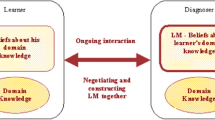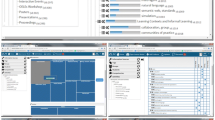Abstract
Our work explores an interactive open learner modelling (IOLM) approach where learner diagnosis is considered as an interactive process involving both a computer system and a learner that play symmetrical (to a certain extent) roles and construct together the learner model. The paper presents an application of IOLM for diagnosing and fostering a learner’s conceptual understanding in a terminological domain. Based on an experimental study, we discuss computational and educational benefits of IOLM in terms of improving the quality of the obtained learner model and fostering reflective thinking.
Preview
Unable to display preview. Download preview PDF.
Similar content being viewed by others
References
Angelova, G., Nenkova, A., Boycheva, Sv., & Nikolov T. (2000). CGs as a knowledge representation core in a complex language learning environment. In B. Ganter & G.W. Mineau (eds.), Proc. of int. conference on conceptual structures. Shaker Verlag, 45–58.
Boud, D., Keogh, R., & Walker, D. (1996). What is reflection in learning. In D. Boud, R. Keogh, & D. Walker (eds.), Reflection: turning experience into learning. Kogan Page,7–17.
Boytcheva, S. Kalaydgjiev, O. Nenkova, A. & Angelova G. (2000). Integration of resources and components in a knowledge-based web environment for terminology learning. In S. Cerri & D. Dochev (eds.), AI: methodology, systems and applications. Springer, 210–220.
Bull, S. (1997). Collaborative student modelling in foreign language learning. PhD Thesis. University of Edinburgh.
Chanier, T. (1996). Learning a second language for specific purposes within a hypermedia framework. Computer Assisted Language Learning, 9(1), 3–43.
Dewey, J. (1960). How we think-a restatement of the relation of reflective thinking to the educational process. D.C. Heath and Company.
Dimitrova, V. (in preparation). Interactive open learner modeling. PhD Thesis. Computer Based Learning Unit, Leeds University, expected submission in April 2001.
Dimitrova, V., Self, J.A. & Brna, P. (1999). The interactive maintenance of open learner models.In S Lajoie & M. Vivet (eds.),Artificial intelligence in education. IOS Press, 405–412.
Dimitrova, V., Self, J.A. & Brna, P. (2000). Maintaining a jointly constructed student model. In S. Cerri & D. Dochev (eds.), AI: Methodology, Systems and Applications, Springer, 221–231.
Kay J. (1999). A scrutable user modelling shell for user-adapted interaction. Ph.D. Thesis, Basser Department of Computer Science, University of Sydney, Sydney, Australia.
Morales, R., Pain, H., & Conlon, T. (2000). Understandable learner models for a sensorimotor control task. In G. Gauthier & C. Frasson, ITS’2000, Berlin: Springer, 222–231.
Morales, R., Pain, H., Bull, S., & Kay, J. (1999). Workshop on open, interactive, and other overt approaches to learner modeling. AIED’99, Le Mans, France.
Paiva, A. & Self, J.A. (1995). TAGUS-a user and learner modelling workbench, User Modeling and User-Adapted Interaction, 4, 197–226.
Self, J.A. (1990). Bypassing the intractable problem of student modeling. In C. Frasson & G. Gauthier (eds.),ITS: At the crossroad of artificial intelligence and education, NJ: Ablex.
Singer, M. (1990). Psychology of language: An introduction of sentence and discourse processes, Lawrence Erlbaum Assoc.
Smith, J. (1998). Everyone’s ABC of accounting language http://www.//soc.staffs.ac.uk/~cmrjs/agloss.htm.
Thagard, P. (1992). Conceptual revolutions. Princeton University Press.
Author information
Authors and Affiliations
Editor information
Editors and Affiliations
Rights and permissions
Copyright information
© 2001 Springer-Verlag Berlin Heidelberg
About this paper
Cite this paper
Dimitrova, V., Self, J., Brna, P. (2001). Applying Interactive Open Learner Models to Learning Technical Terminology. In: Bauer, M., Gmytrasiewicz, P.J., Vassileva, J. (eds) User Modeling 2001. UM 2001. Lecture Notes in Computer Science(), vol 2109. Springer, Berlin, Heidelberg. https://doi.org/10.1007/3-540-44566-8_15
Download citation
DOI: https://doi.org/10.1007/3-540-44566-8_15
Published:
Publisher Name: Springer, Berlin, Heidelberg
Print ISBN: 978-3-540-42325-6
Online ISBN: 978-3-540-44566-1
eBook Packages: Springer Book Archive




